Case Study: Analyzing Client Health Information - Nursing Diploma
VerifiedAdded on 2023/06/11
|18
|2818
|150
Case Study
AI Summary
This document presents a comprehensive case study assessment covering various aspects of nursing, including the endocrine, respiratory, lymphatic, urinary, and reproductive systems. It addresses conditions such as Graves' disease, COPD, and stress incontinence, detailing their pathophysiology, risk factors, and nursing interventions. The assessment includes analyses of blood test reports, vital signs, and the impact of age on different body systems. Additionally, it outlines the roles of various healthcare professionals in patient care and discusses types of immunity. The case study also explores the structure and function of key organs and systems, providing a holistic view of patient health and nursing practice.
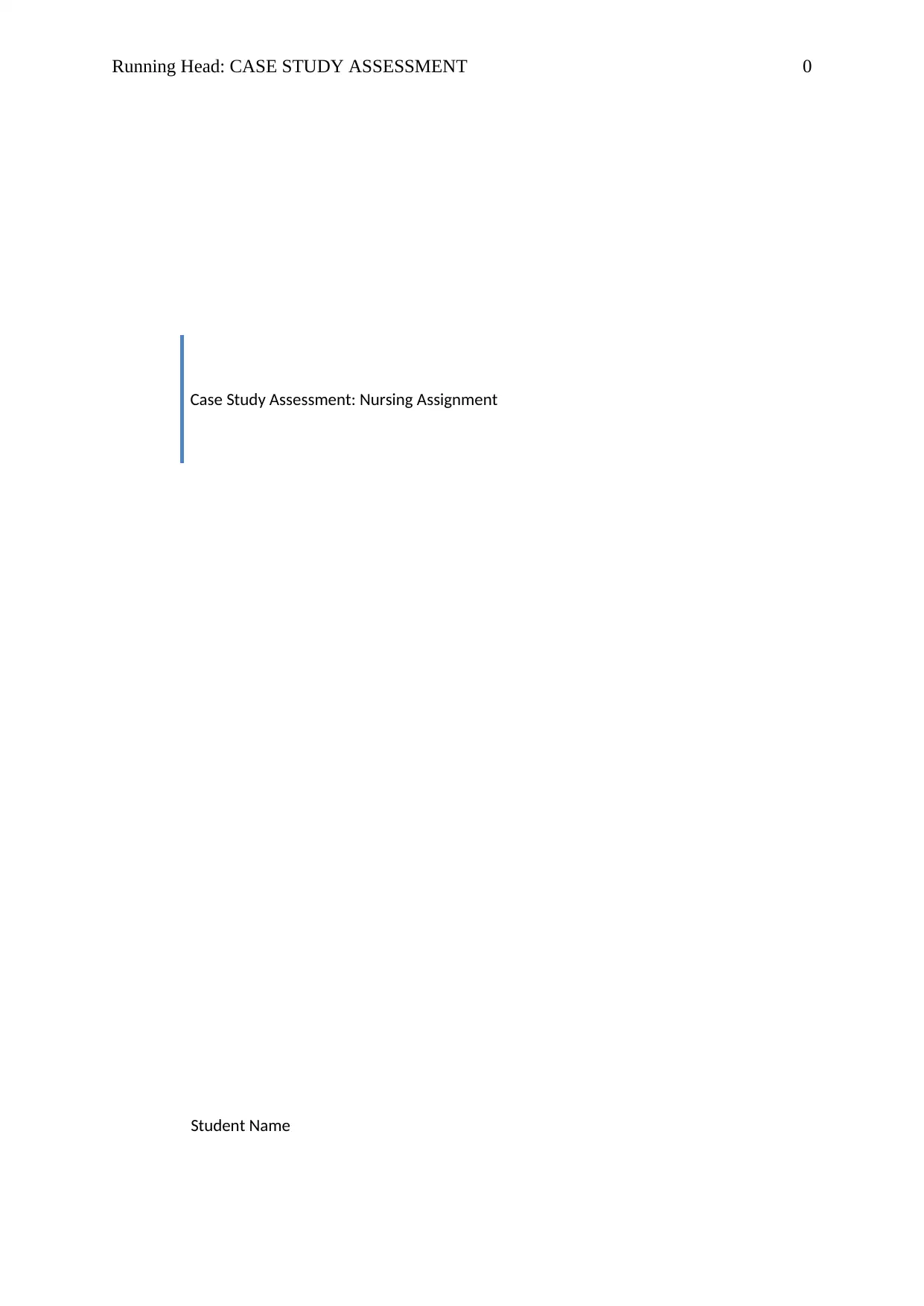
Running Head: CASE STUDY ASSESSMENT 0
Case Study Assessment: Nursing Assignment
Student Name
Case Study Assessment: Nursing Assignment
Student Name
Paraphrase This Document
Need a fresh take? Get an instant paraphrase of this document with our AI Paraphraser
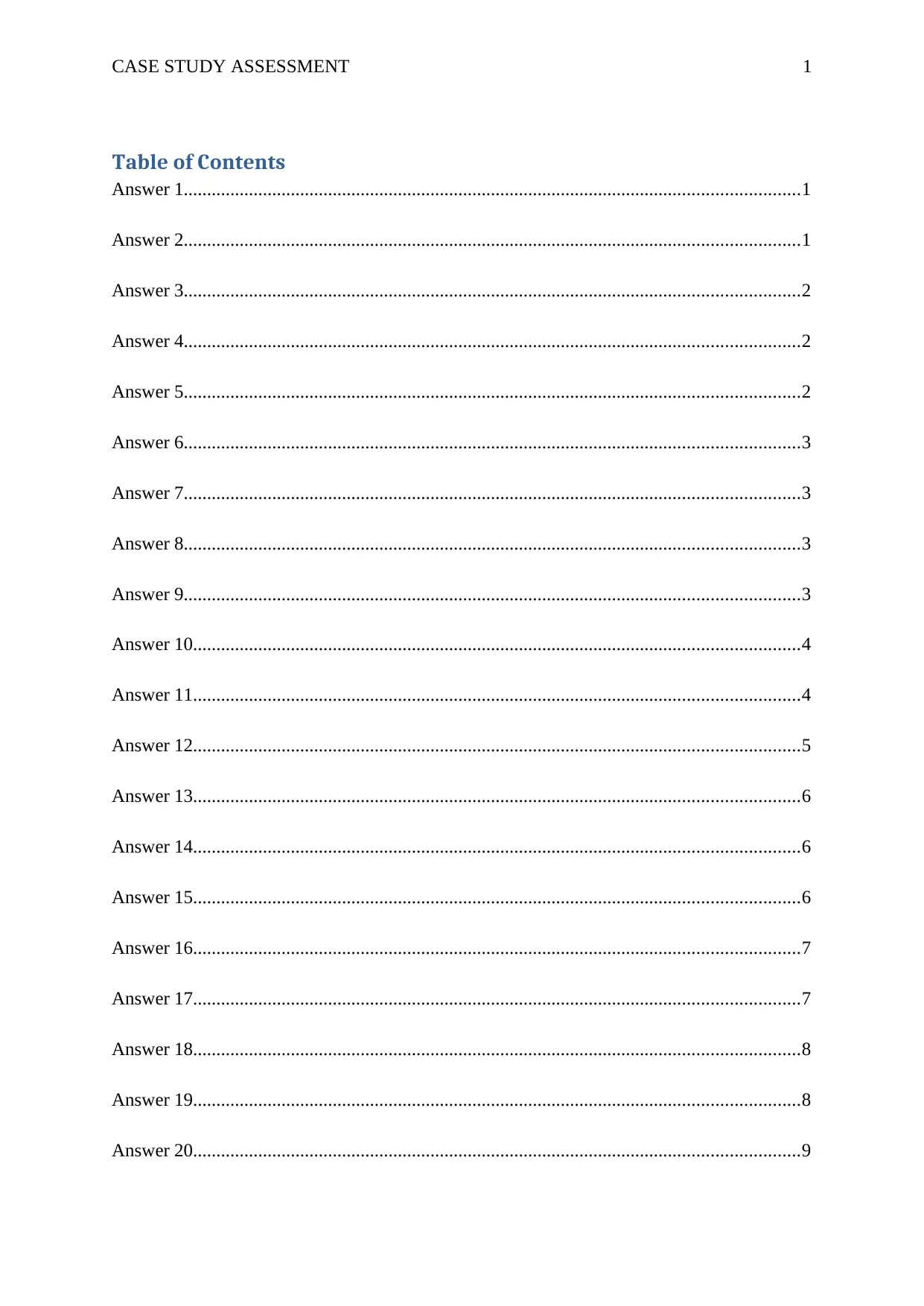
CASE STUDY ASSESSMENT 1
Table of Contents
Answer 1....................................................................................................................................1
Answer 2....................................................................................................................................1
Answer 3....................................................................................................................................2
Answer 4....................................................................................................................................2
Answer 5....................................................................................................................................2
Answer 6....................................................................................................................................3
Answer 7....................................................................................................................................3
Answer 8....................................................................................................................................3
Answer 9....................................................................................................................................3
Answer 10..................................................................................................................................4
Answer 11..................................................................................................................................4
Answer 12..................................................................................................................................5
Answer 13..................................................................................................................................6
Answer 14..................................................................................................................................6
Answer 15..................................................................................................................................6
Answer 16..................................................................................................................................7
Answer 17..................................................................................................................................7
Answer 18..................................................................................................................................8
Answer 19..................................................................................................................................8
Answer 20..................................................................................................................................9
Table of Contents
Answer 1....................................................................................................................................1
Answer 2....................................................................................................................................1
Answer 3....................................................................................................................................2
Answer 4....................................................................................................................................2
Answer 5....................................................................................................................................2
Answer 6....................................................................................................................................3
Answer 7....................................................................................................................................3
Answer 8....................................................................................................................................3
Answer 9....................................................................................................................................3
Answer 10..................................................................................................................................4
Answer 11..................................................................................................................................4
Answer 12..................................................................................................................................5
Answer 13..................................................................................................................................6
Answer 14..................................................................................................................................6
Answer 15..................................................................................................................................6
Answer 16..................................................................................................................................7
Answer 17..................................................................................................................................7
Answer 18..................................................................................................................................8
Answer 19..................................................................................................................................8
Answer 20..................................................................................................................................9
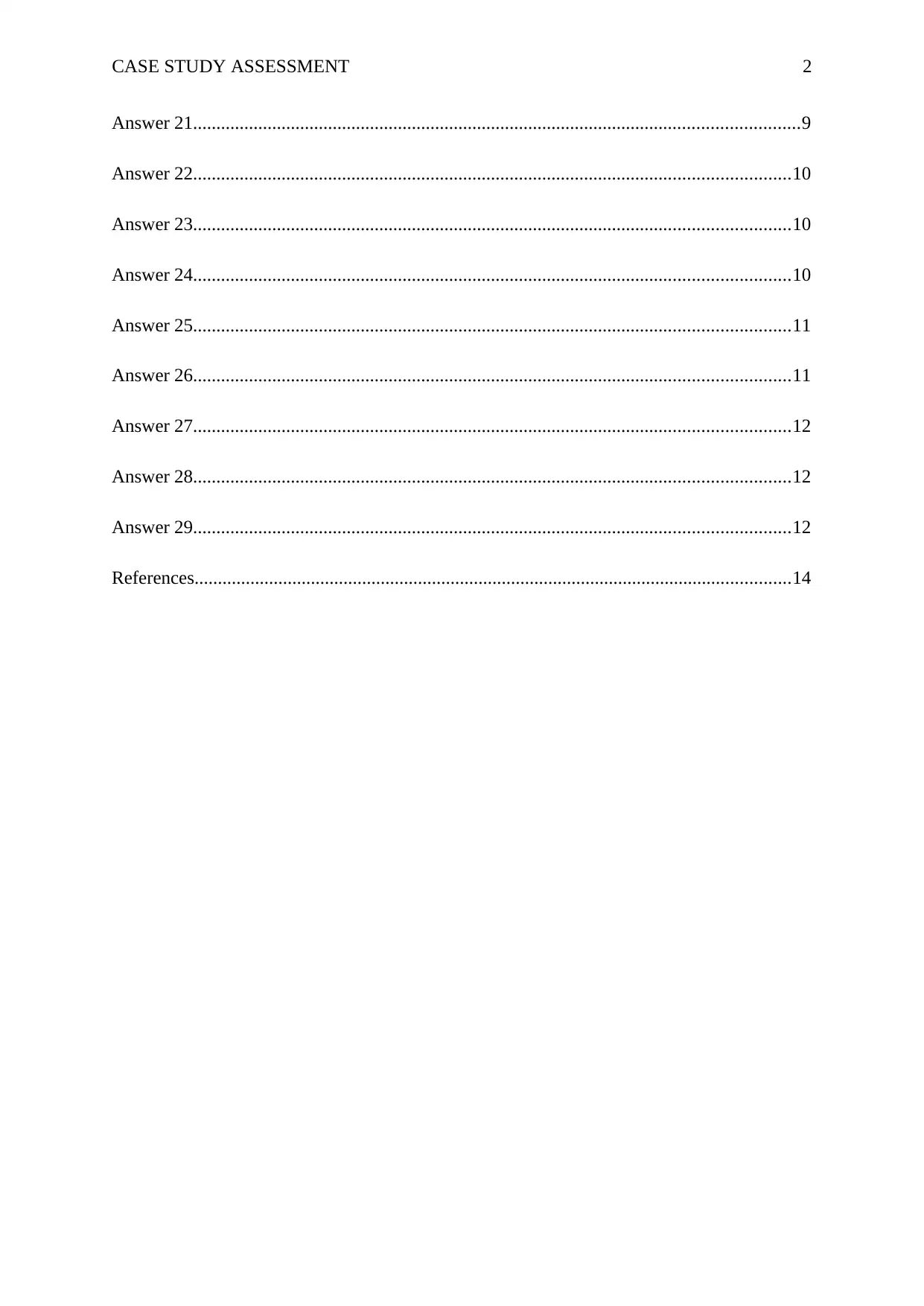
CASE STUDY ASSESSMENT 2
Answer 21..................................................................................................................................9
Answer 22................................................................................................................................10
Answer 23................................................................................................................................10
Answer 24................................................................................................................................10
Answer 25................................................................................................................................11
Answer 26................................................................................................................................11
Answer 27................................................................................................................................12
Answer 28................................................................................................................................12
Answer 29................................................................................................................................12
References................................................................................................................................14
Answer 21..................................................................................................................................9
Answer 22................................................................................................................................10
Answer 23................................................................................................................................10
Answer 24................................................................................................................................10
Answer 25................................................................................................................................11
Answer 26................................................................................................................................11
Answer 27................................................................................................................................12
Answer 28................................................................................................................................12
Answer 29................................................................................................................................12
References................................................................................................................................14
⊘ This is a preview!⊘
Do you want full access?
Subscribe today to unlock all pages.

Trusted by 1+ million students worldwide
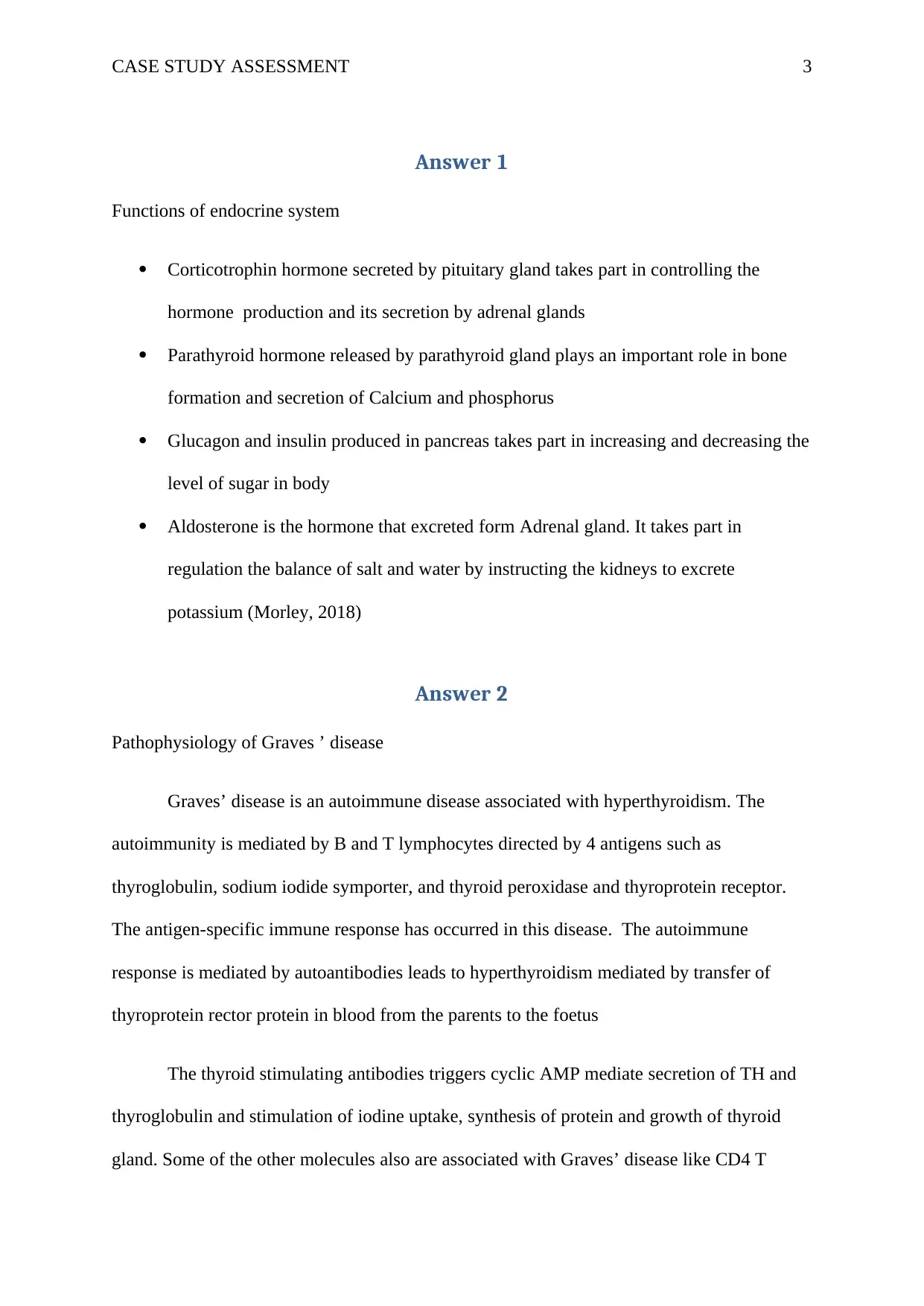
CASE STUDY ASSESSMENT 3
Answer 1
Functions of endocrine system
Corticotrophin hormone secreted by pituitary gland takes part in controlling the
hormone production and its secretion by adrenal glands
Parathyroid hormone released by parathyroid gland plays an important role in bone
formation and secretion of Calcium and phosphorus
Glucagon and insulin produced in pancreas takes part in increasing and decreasing the
level of sugar in body
Aldosterone is the hormone that excreted form Adrenal gland. It takes part in
regulation the balance of salt and water by instructing the kidneys to excrete
potassium (Morley, 2018)
Answer 2
Pathophysiology of Graves ’ disease
Graves’ disease is an autoimmune disease associated with hyperthyroidism. The
autoimmunity is mediated by B and T lymphocytes directed by 4 antigens such as
thyroglobulin, sodium iodide symporter, and thyroid peroxidase and thyroprotein receptor.
The antigen-specific immune response has occurred in this disease. The autoimmune
response is mediated by autoantibodies leads to hyperthyroidism mediated by transfer of
thyroprotein rector protein in blood from the parents to the foetus
The thyroid stimulating antibodies triggers cyclic AMP mediate secretion of TH and
thyroglobulin and stimulation of iodine uptake, synthesis of protein and growth of thyroid
gland. Some of the other molecules also are associated with Graves’ disease like CD4 T
Answer 1
Functions of endocrine system
Corticotrophin hormone secreted by pituitary gland takes part in controlling the
hormone production and its secretion by adrenal glands
Parathyroid hormone released by parathyroid gland plays an important role in bone
formation and secretion of Calcium and phosphorus
Glucagon and insulin produced in pancreas takes part in increasing and decreasing the
level of sugar in body
Aldosterone is the hormone that excreted form Adrenal gland. It takes part in
regulation the balance of salt and water by instructing the kidneys to excrete
potassium (Morley, 2018)
Answer 2
Pathophysiology of Graves ’ disease
Graves’ disease is an autoimmune disease associated with hyperthyroidism. The
autoimmunity is mediated by B and T lymphocytes directed by 4 antigens such as
thyroglobulin, sodium iodide symporter, and thyroid peroxidase and thyroprotein receptor.
The antigen-specific immune response has occurred in this disease. The autoimmune
response is mediated by autoantibodies leads to hyperthyroidism mediated by transfer of
thyroprotein rector protein in blood from the parents to the foetus
The thyroid stimulating antibodies triggers cyclic AMP mediate secretion of TH and
thyroglobulin and stimulation of iodine uptake, synthesis of protein and growth of thyroid
gland. Some of the other molecules also are associated with Graves’ disease like CD4 T
Paraphrase This Document
Need a fresh take? Get an instant paraphrase of this document with our AI Paraphraser
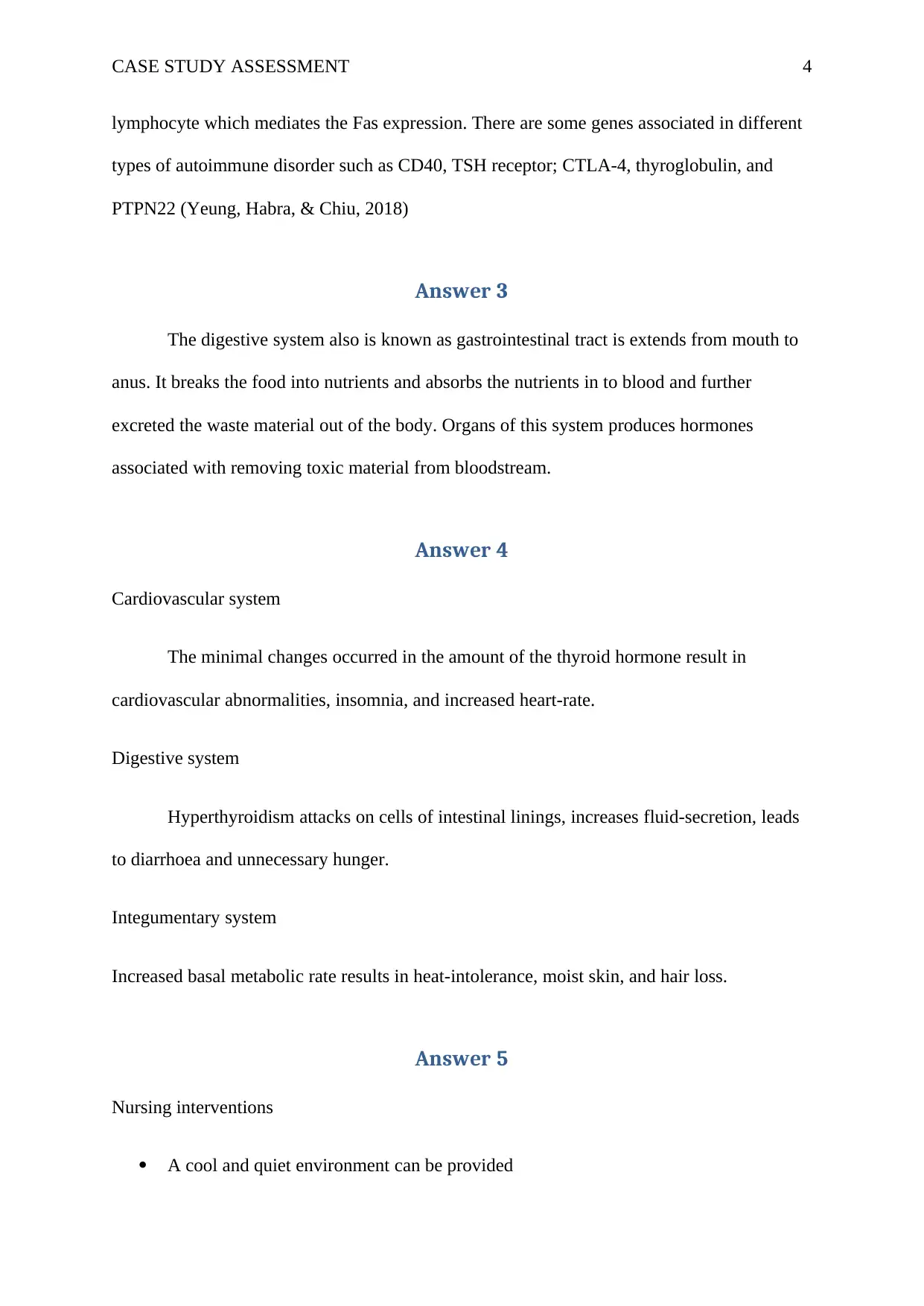
CASE STUDY ASSESSMENT 4
lymphocyte which mediates the Fas expression. There are some genes associated in different
types of autoimmune disorder such as CD40, TSH receptor; CTLA-4, thyroglobulin, and
PTPN22 (Yeung, Habra, & Chiu, 2018)
Answer 3
The digestive system also is known as gastrointestinal tract is extends from mouth to
anus. It breaks the food into nutrients and absorbs the nutrients in to blood and further
excreted the waste material out of the body. Organs of this system produces hormones
associated with removing toxic material from bloodstream.
Answer 4
Cardiovascular system
The minimal changes occurred in the amount of the thyroid hormone result in
cardiovascular abnormalities, insomnia, and increased heart-rate.
Digestive system
Hyperthyroidism attacks on cells of intestinal linings, increases fluid-secretion, leads
to diarrhoea and unnecessary hunger.
Integumentary system
Increased basal metabolic rate results in heat-intolerance, moist skin, and hair loss.
Answer 5
Nursing interventions
A cool and quiet environment can be provided
lymphocyte which mediates the Fas expression. There are some genes associated in different
types of autoimmune disorder such as CD40, TSH receptor; CTLA-4, thyroglobulin, and
PTPN22 (Yeung, Habra, & Chiu, 2018)
Answer 3
The digestive system also is known as gastrointestinal tract is extends from mouth to
anus. It breaks the food into nutrients and absorbs the nutrients in to blood and further
excreted the waste material out of the body. Organs of this system produces hormones
associated with removing toxic material from bloodstream.
Answer 4
Cardiovascular system
The minimal changes occurred in the amount of the thyroid hormone result in
cardiovascular abnormalities, insomnia, and increased heart-rate.
Digestive system
Hyperthyroidism attacks on cells of intestinal linings, increases fluid-secretion, leads
to diarrhoea and unnecessary hunger.
Integumentary system
Increased basal metabolic rate results in heat-intolerance, moist skin, and hair loss.
Answer 5
Nursing interventions
A cool and quiet environment can be provided
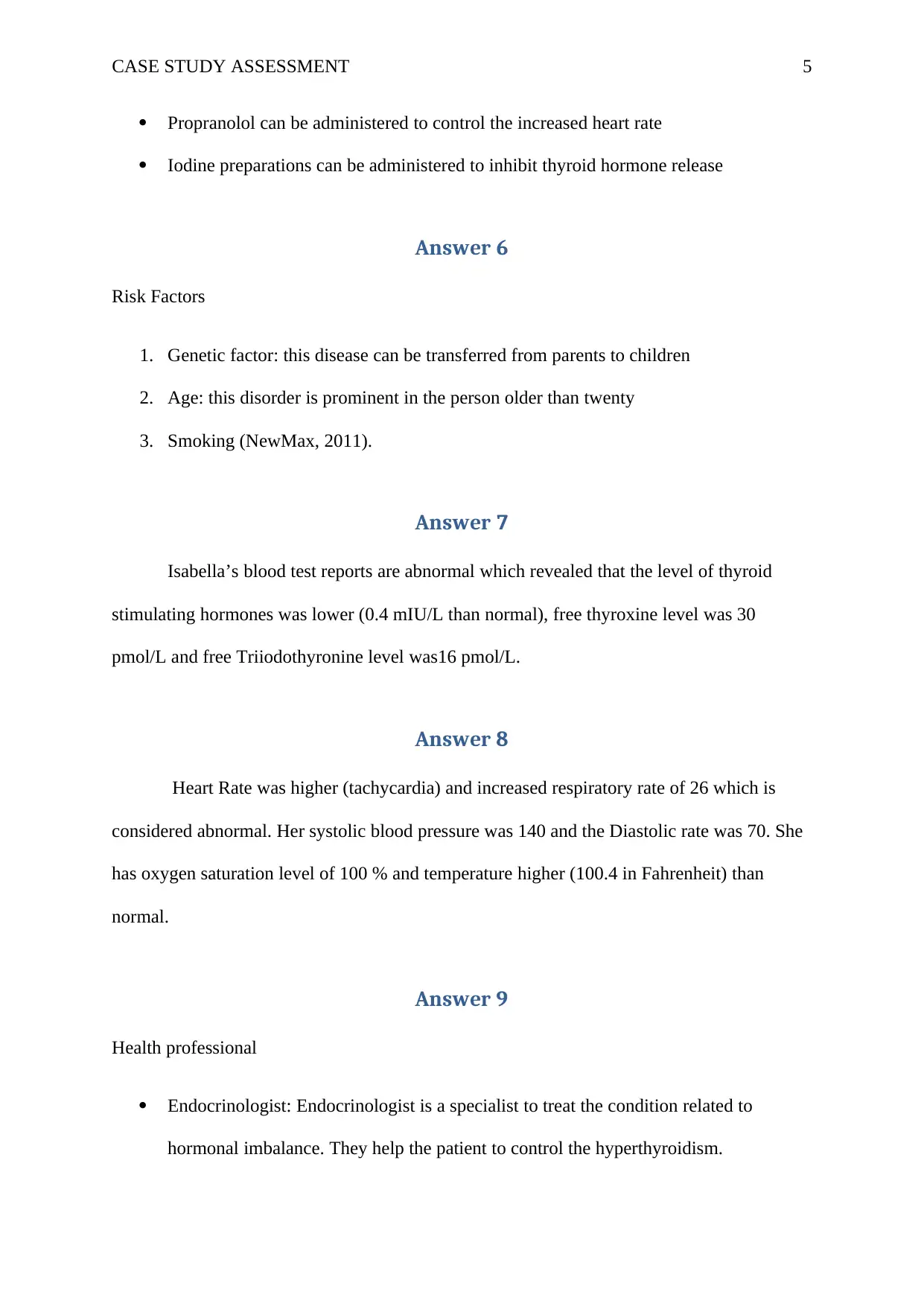
CASE STUDY ASSESSMENT 5
Propranolol can be administered to control the increased heart rate
Iodine preparations can be administered to inhibit thyroid hormone release
Answer 6
Risk Factors
1. Genetic factor: this disease can be transferred from parents to children
2. Age: this disorder is prominent in the person older than twenty
3. Smoking (NewMax, 2011).
Answer 7
Isabella’s blood test reports are abnormal which revealed that the level of thyroid
stimulating hormones was lower (0.4 mIU/L than normal), free thyroxine level was 30
pmol/L and free Triiodothyronine level was16 pmol/L.
Answer 8
Heart Rate was higher (tachycardia) and increased respiratory rate of 26 which is
considered abnormal. Her systolic blood pressure was 140 and the Diastolic rate was 70. She
has oxygen saturation level of 100 % and temperature higher (100.4 in Fahrenheit) than
normal.
Answer 9
Health professional
Endocrinologist: Endocrinologist is a specialist to treat the condition related to
hormonal imbalance. They help the patient to control the hyperthyroidism.
Propranolol can be administered to control the increased heart rate
Iodine preparations can be administered to inhibit thyroid hormone release
Answer 6
Risk Factors
1. Genetic factor: this disease can be transferred from parents to children
2. Age: this disorder is prominent in the person older than twenty
3. Smoking (NewMax, 2011).
Answer 7
Isabella’s blood test reports are abnormal which revealed that the level of thyroid
stimulating hormones was lower (0.4 mIU/L than normal), free thyroxine level was 30
pmol/L and free Triiodothyronine level was16 pmol/L.
Answer 8
Heart Rate was higher (tachycardia) and increased respiratory rate of 26 which is
considered abnormal. Her systolic blood pressure was 140 and the Diastolic rate was 70. She
has oxygen saturation level of 100 % and temperature higher (100.4 in Fahrenheit) than
normal.
Answer 9
Health professional
Endocrinologist: Endocrinologist is a specialist to treat the condition related to
hormonal imbalance. They help the patient to control the hyperthyroidism.
⊘ This is a preview!⊘
Do you want full access?
Subscribe today to unlock all pages.

Trusted by 1+ million students worldwide
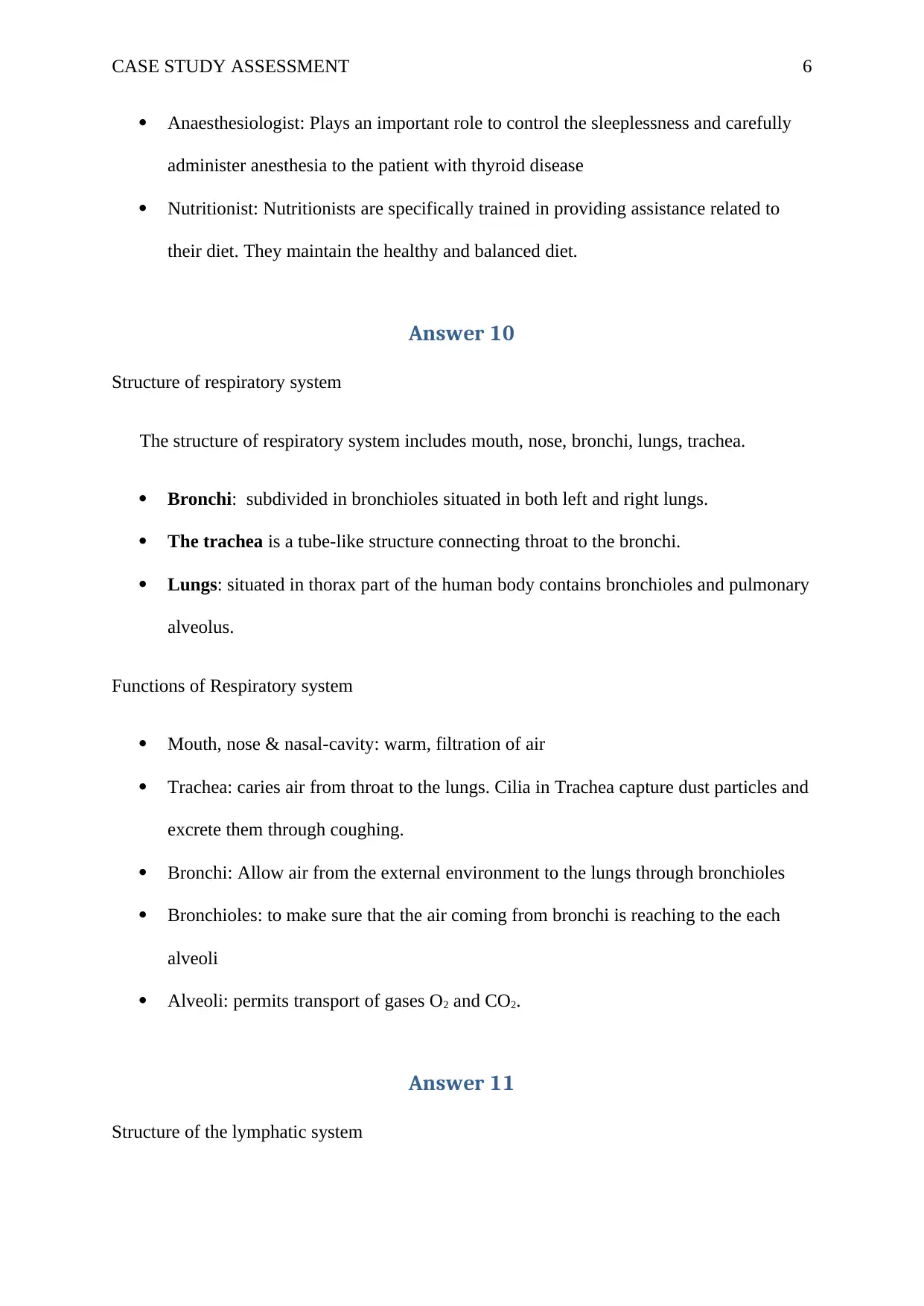
CASE STUDY ASSESSMENT 6
Anaesthesiologist: Plays an important role to control the sleeplessness and carefully
administer anesthesia to the patient with thyroid disease
Nutritionist: Nutritionists are specifically trained in providing assistance related to
their diet. They maintain the healthy and balanced diet.
Answer 10
Structure of respiratory system
The structure of respiratory system includes mouth, nose, bronchi, lungs, trachea.
Bronchi: subdivided in bronchioles situated in both left and right lungs.
The trachea is a tube-like structure connecting throat to the bronchi.
Lungs: situated in thorax part of the human body contains bronchioles and pulmonary
alveolus.
Functions of Respiratory system
Mouth, nose & nasal-cavity: warm, filtration of air
Trachea: caries air from throat to the lungs. Cilia in Trachea capture dust particles and
excrete them through coughing.
Bronchi: Allow air from the external environment to the lungs through bronchioles
Bronchioles: to make sure that the air coming from bronchi is reaching to the each
alveoli
Alveoli: permits transport of gases O2 and CO2.
Answer 11
Structure of the lymphatic system
Anaesthesiologist: Plays an important role to control the sleeplessness and carefully
administer anesthesia to the patient with thyroid disease
Nutritionist: Nutritionists are specifically trained in providing assistance related to
their diet. They maintain the healthy and balanced diet.
Answer 10
Structure of respiratory system
The structure of respiratory system includes mouth, nose, bronchi, lungs, trachea.
Bronchi: subdivided in bronchioles situated in both left and right lungs.
The trachea is a tube-like structure connecting throat to the bronchi.
Lungs: situated in thorax part of the human body contains bronchioles and pulmonary
alveolus.
Functions of Respiratory system
Mouth, nose & nasal-cavity: warm, filtration of air
Trachea: caries air from throat to the lungs. Cilia in Trachea capture dust particles and
excrete them through coughing.
Bronchi: Allow air from the external environment to the lungs through bronchioles
Bronchioles: to make sure that the air coming from bronchi is reaching to the each
alveoli
Alveoli: permits transport of gases O2 and CO2.
Answer 11
Structure of the lymphatic system
Paraphrase This Document
Need a fresh take? Get an instant paraphrase of this document with our AI Paraphraser
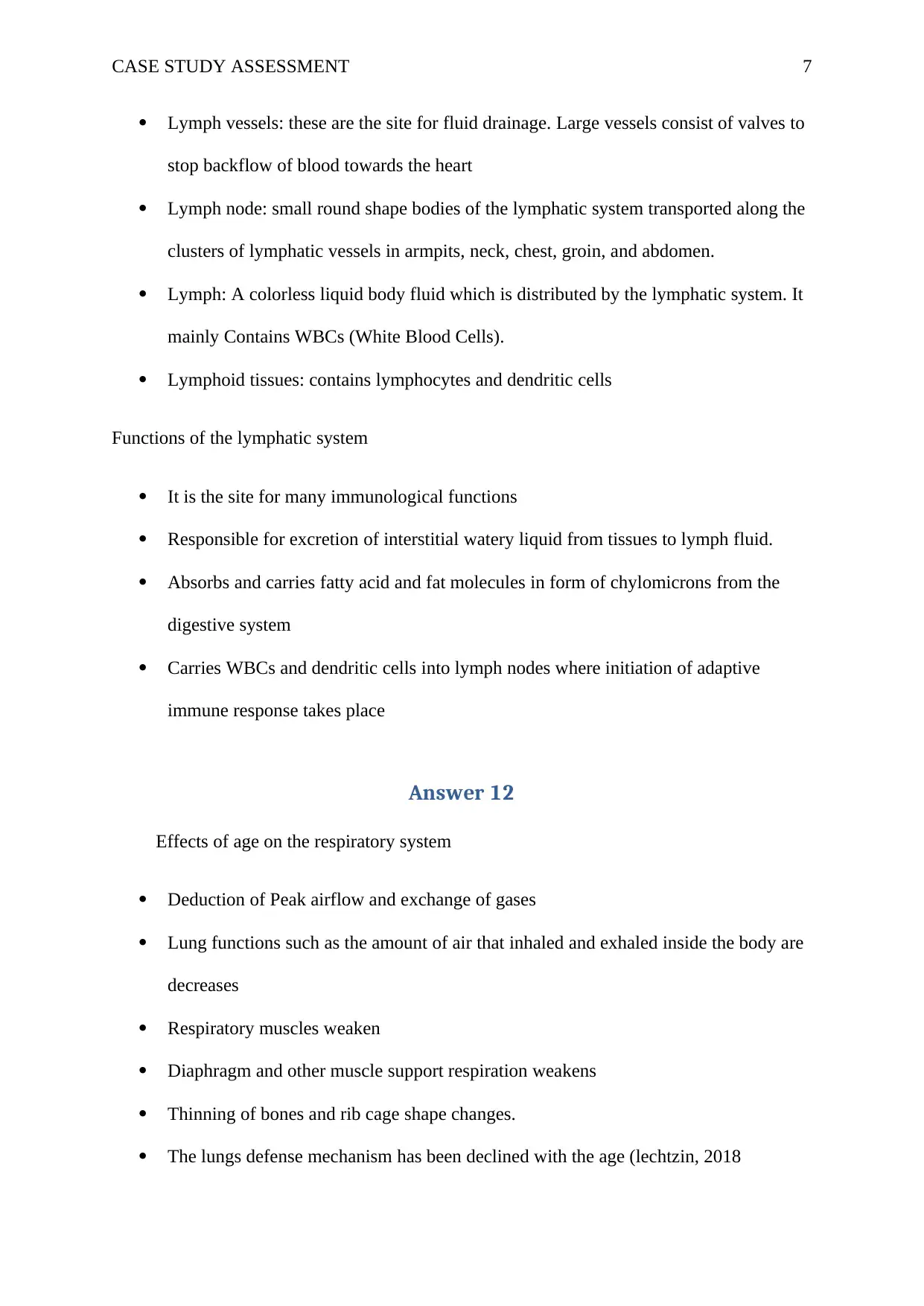
CASE STUDY ASSESSMENT 7
Lymph vessels: these are the site for fluid drainage. Large vessels consist of valves to
stop backflow of blood towards the heart
Lymph node: small round shape bodies of the lymphatic system transported along the
clusters of lymphatic vessels in armpits, neck, chest, groin, and abdomen.
Lymph: A colorless liquid body fluid which is distributed by the lymphatic system. It
mainly Contains WBCs (White Blood Cells).
Lymphoid tissues: contains lymphocytes and dendritic cells
Functions of the lymphatic system
It is the site for many immunological functions
Responsible for excretion of interstitial watery liquid from tissues to lymph fluid.
Absorbs and carries fatty acid and fat molecules in form of chylomicrons from the
digestive system
Carries WBCs and dendritic cells into lymph nodes where initiation of adaptive
immune response takes place
Answer 12
Effects of age on the respiratory system
Deduction of Peak airflow and exchange of gases
Lung functions such as the amount of air that inhaled and exhaled inside the body are
decreases
Respiratory muscles weaken
Diaphragm and other muscle support respiration weakens
Thinning of bones and rib cage shape changes.
The lungs defense mechanism has been declined with the age (lechtzin, 2018
Lymph vessels: these are the site for fluid drainage. Large vessels consist of valves to
stop backflow of blood towards the heart
Lymph node: small round shape bodies of the lymphatic system transported along the
clusters of lymphatic vessels in armpits, neck, chest, groin, and abdomen.
Lymph: A colorless liquid body fluid which is distributed by the lymphatic system. It
mainly Contains WBCs (White Blood Cells).
Lymphoid tissues: contains lymphocytes and dendritic cells
Functions of the lymphatic system
It is the site for many immunological functions
Responsible for excretion of interstitial watery liquid from tissues to lymph fluid.
Absorbs and carries fatty acid and fat molecules in form of chylomicrons from the
digestive system
Carries WBCs and dendritic cells into lymph nodes where initiation of adaptive
immune response takes place
Answer 12
Effects of age on the respiratory system
Deduction of Peak airflow and exchange of gases
Lung functions such as the amount of air that inhaled and exhaled inside the body are
decreases
Respiratory muscles weaken
Diaphragm and other muscle support respiration weakens
Thinning of bones and rib cage shape changes.
The lungs defense mechanism has been declined with the age (lechtzin, 2018
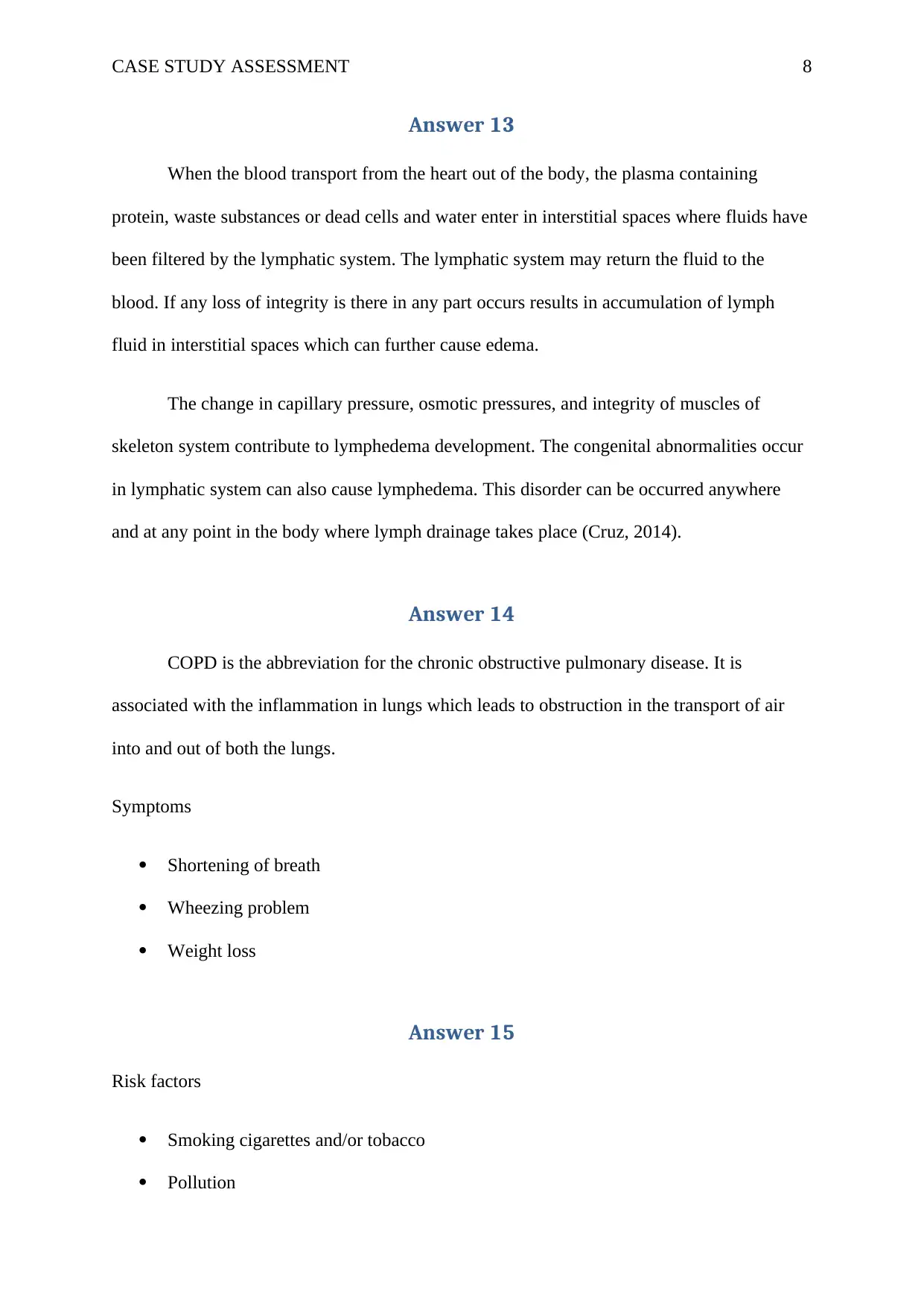
CASE STUDY ASSESSMENT 8
Answer 13
When the blood transport from the heart out of the body, the plasma containing
protein, waste substances or dead cells and water enter in interstitial spaces where fluids have
been filtered by the lymphatic system. The lymphatic system may return the fluid to the
blood. If any loss of integrity is there in any part occurs results in accumulation of lymph
fluid in interstitial spaces which can further cause edema.
The change in capillary pressure, osmotic pressures, and integrity of muscles of
skeleton system contribute to lymphedema development. The congenital abnormalities occur
in lymphatic system can also cause lymphedema. This disorder can be occurred anywhere
and at any point in the body where lymph drainage takes place (Cruz, 2014).
Answer 14
COPD is the abbreviation for the chronic obstructive pulmonary disease. It is
associated with the inflammation in lungs which leads to obstruction in the transport of air
into and out of both the lungs.
Symptoms
Shortening of breath
Wheezing problem
Weight loss
Answer 15
Risk factors
Smoking cigarettes and/or tobacco
Pollution
Answer 13
When the blood transport from the heart out of the body, the plasma containing
protein, waste substances or dead cells and water enter in interstitial spaces where fluids have
been filtered by the lymphatic system. The lymphatic system may return the fluid to the
blood. If any loss of integrity is there in any part occurs results in accumulation of lymph
fluid in interstitial spaces which can further cause edema.
The change in capillary pressure, osmotic pressures, and integrity of muscles of
skeleton system contribute to lymphedema development. The congenital abnormalities occur
in lymphatic system can also cause lymphedema. This disorder can be occurred anywhere
and at any point in the body where lymph drainage takes place (Cruz, 2014).
Answer 14
COPD is the abbreviation for the chronic obstructive pulmonary disease. It is
associated with the inflammation in lungs which leads to obstruction in the transport of air
into and out of both the lungs.
Symptoms
Shortening of breath
Wheezing problem
Weight loss
Answer 15
Risk factors
Smoking cigarettes and/or tobacco
Pollution
⊘ This is a preview!⊘
Do you want full access?
Subscribe today to unlock all pages.

Trusted by 1+ million students worldwide
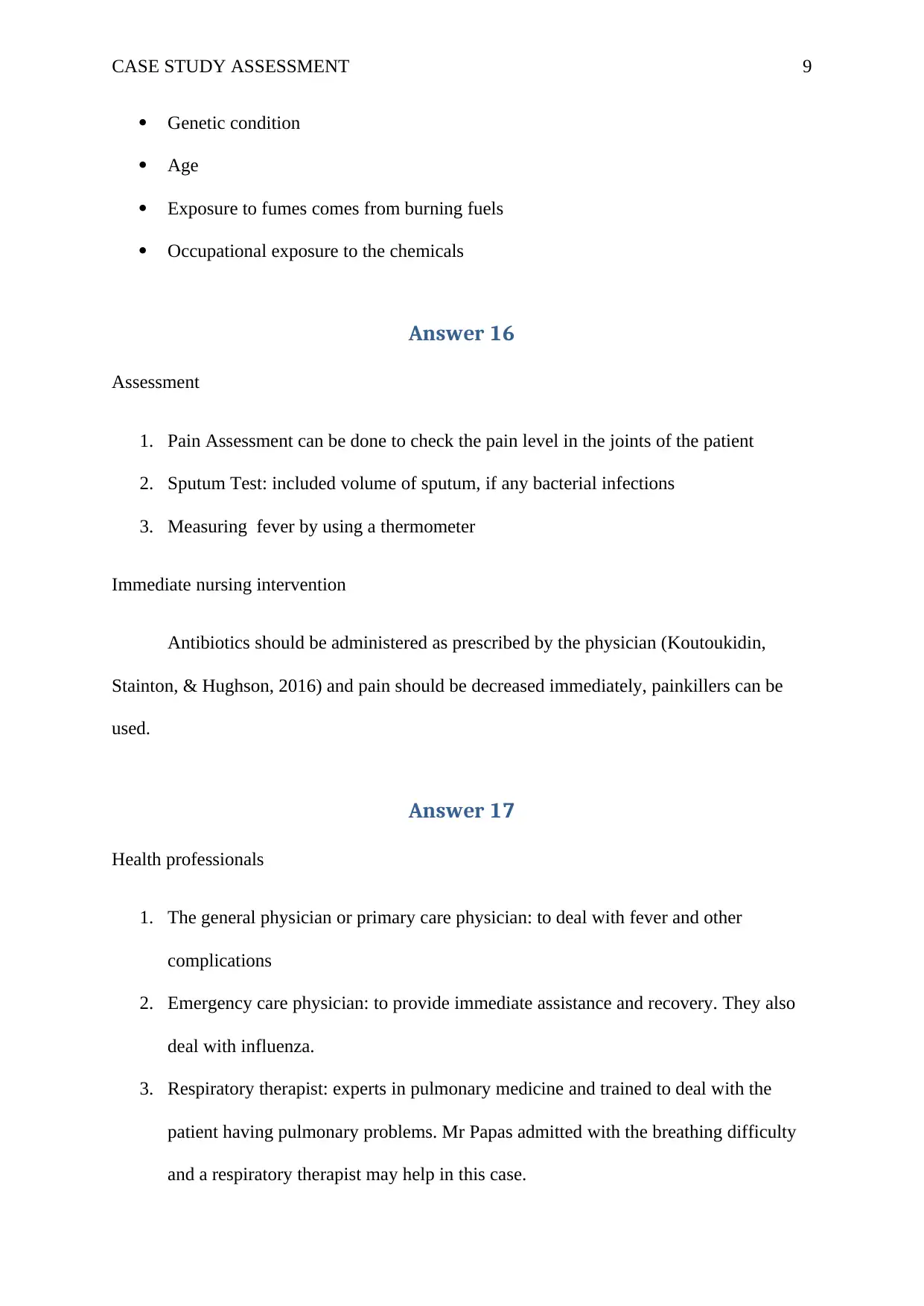
CASE STUDY ASSESSMENT 9
Genetic condition
Age
Exposure to fumes comes from burning fuels
Occupational exposure to the chemicals
Answer 16
Assessment
1. Pain Assessment can be done to check the pain level in the joints of the patient
2. Sputum Test: included volume of sputum, if any bacterial infections
3. Measuring fever by using a thermometer
Immediate nursing intervention
Antibiotics should be administered as prescribed by the physician (Koutoukidin,
Stainton, & Hughson, 2016) and pain should be decreased immediately, painkillers can be
used.
Answer 17
Health professionals
1. The general physician or primary care physician: to deal with fever and other
complications
2. Emergency care physician: to provide immediate assistance and recovery. They also
deal with influenza.
3. Respiratory therapist: experts in pulmonary medicine and trained to deal with the
patient having pulmonary problems. Mr Papas admitted with the breathing difficulty
and a respiratory therapist may help in this case.
Genetic condition
Age
Exposure to fumes comes from burning fuels
Occupational exposure to the chemicals
Answer 16
Assessment
1. Pain Assessment can be done to check the pain level in the joints of the patient
2. Sputum Test: included volume of sputum, if any bacterial infections
3. Measuring fever by using a thermometer
Immediate nursing intervention
Antibiotics should be administered as prescribed by the physician (Koutoukidin,
Stainton, & Hughson, 2016) and pain should be decreased immediately, painkillers can be
used.
Answer 17
Health professionals
1. The general physician or primary care physician: to deal with fever and other
complications
2. Emergency care physician: to provide immediate assistance and recovery. They also
deal with influenza.
3. Respiratory therapist: experts in pulmonary medicine and trained to deal with the
patient having pulmonary problems. Mr Papas admitted with the breathing difficulty
and a respiratory therapist may help in this case.
Paraphrase This Document
Need a fresh take? Get an instant paraphrase of this document with our AI Paraphraser
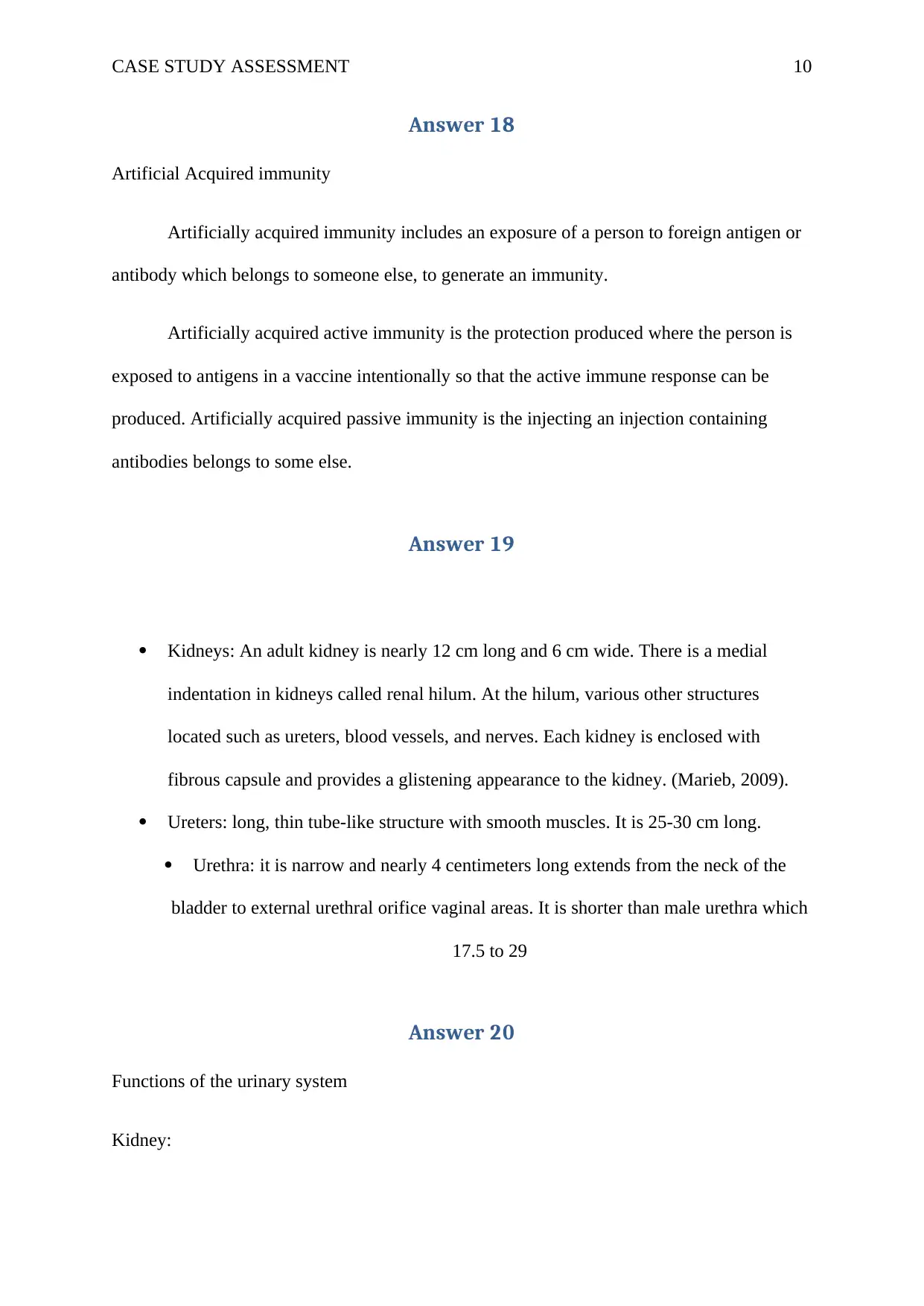
CASE STUDY ASSESSMENT 10
Answer 18
Artificial Acquired immunity
Artificially acquired immunity includes an exposure of a person to foreign antigen or
antibody which belongs to someone else, to generate an immunity.
Artificially acquired active immunity is the protection produced where the person is
exposed to antigens in a vaccine intentionally so that the active immune response can be
produced. Artificially acquired passive immunity is the injecting an injection containing
antibodies belongs to some else.
Answer 19
Kidneys: An adult kidney is nearly 12 cm long and 6 cm wide. There is a medial
indentation in kidneys called renal hilum. At the hilum, various other structures
located such as ureters, blood vessels, and nerves. Each kidney is enclosed with
fibrous capsule and provides a glistening appearance to the kidney. (Marieb, 2009).
Ureters: long, thin tube-like structure with smooth muscles. It is 25-30 cm long.
Urethra: it is narrow and nearly 4 centimeters long extends from the neck of the
bladder to external urethral orifice vaginal areas. It is shorter than male urethra which
17.5 to 29
Answer 20
Functions of the urinary system
Kidney:
Answer 18
Artificial Acquired immunity
Artificially acquired immunity includes an exposure of a person to foreign antigen or
antibody which belongs to someone else, to generate an immunity.
Artificially acquired active immunity is the protection produced where the person is
exposed to antigens in a vaccine intentionally so that the active immune response can be
produced. Artificially acquired passive immunity is the injecting an injection containing
antibodies belongs to some else.
Answer 19
Kidneys: An adult kidney is nearly 12 cm long and 6 cm wide. There is a medial
indentation in kidneys called renal hilum. At the hilum, various other structures
located such as ureters, blood vessels, and nerves. Each kidney is enclosed with
fibrous capsule and provides a glistening appearance to the kidney. (Marieb, 2009).
Ureters: long, thin tube-like structure with smooth muscles. It is 25-30 cm long.
Urethra: it is narrow and nearly 4 centimeters long extends from the neck of the
bladder to external urethral orifice vaginal areas. It is shorter than male urethra which
17.5 to 29
Answer 20
Functions of the urinary system
Kidney:
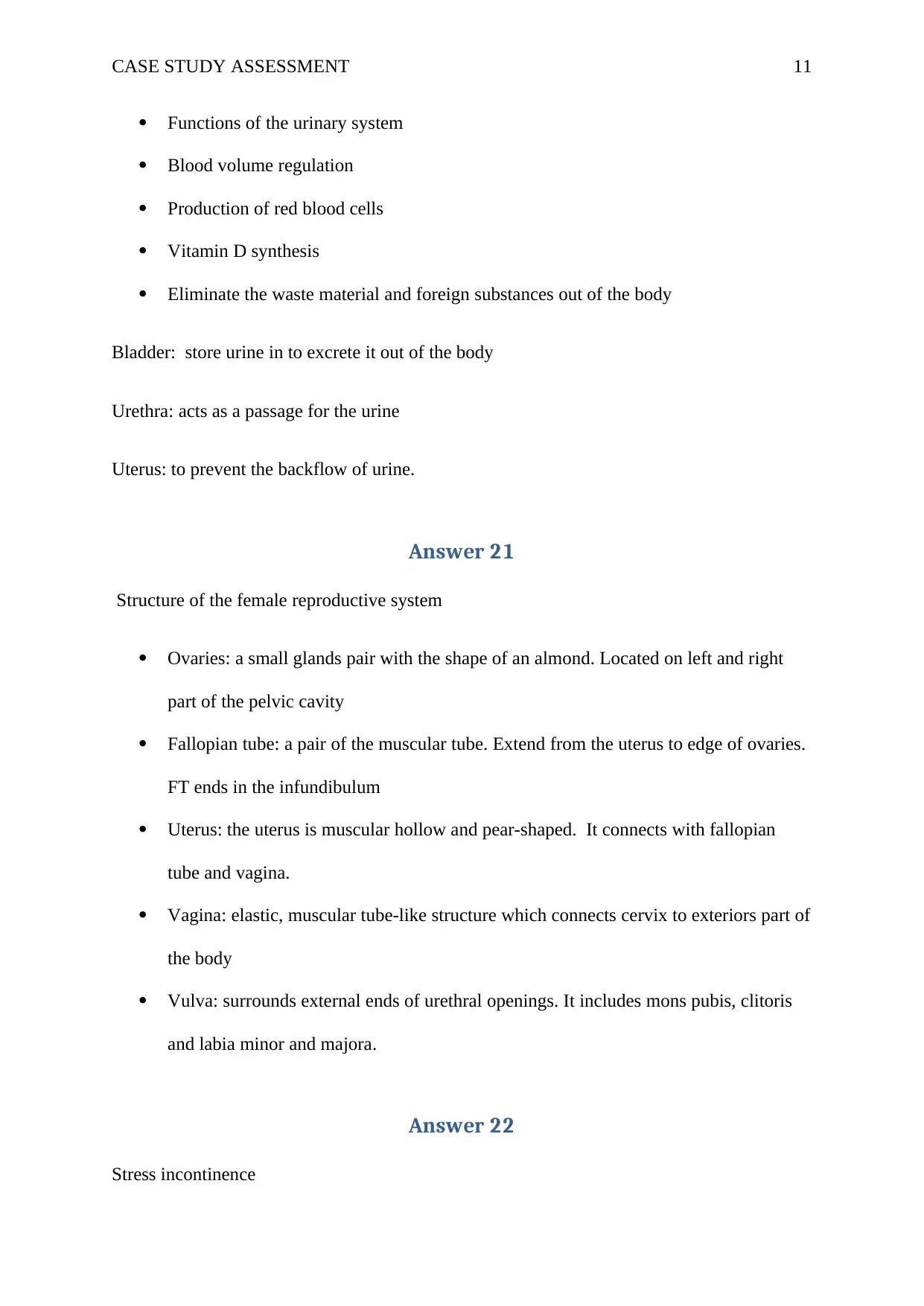
CASE STUDY ASSESSMENT 11
Functions of the urinary system
Blood volume regulation
Production of red blood cells
Vitamin D synthesis
Eliminate the waste material and foreign substances out of the body
Bladder: store urine in to excrete it out of the body
Urethra: acts as a passage for the urine
Uterus: to prevent the backflow of urine.
Answer 21
Structure of the female reproductive system
Ovaries: a small glands pair with the shape of an almond. Located on left and right
part of the pelvic cavity
Fallopian tube: a pair of the muscular tube. Extend from the uterus to edge of ovaries.
FT ends in the infundibulum
Uterus: the uterus is muscular hollow and pear-shaped. It connects with fallopian
tube and vagina.
Vagina: elastic, muscular tube-like structure which connects cervix to exteriors part of
the body
Vulva: surrounds external ends of urethral openings. It includes mons pubis, clitoris
and labia minor and majora.
Answer 22
Stress incontinence
Functions of the urinary system
Blood volume regulation
Production of red blood cells
Vitamin D synthesis
Eliminate the waste material and foreign substances out of the body
Bladder: store urine in to excrete it out of the body
Urethra: acts as a passage for the urine
Uterus: to prevent the backflow of urine.
Answer 21
Structure of the female reproductive system
Ovaries: a small glands pair with the shape of an almond. Located on left and right
part of the pelvic cavity
Fallopian tube: a pair of the muscular tube. Extend from the uterus to edge of ovaries.
FT ends in the infundibulum
Uterus: the uterus is muscular hollow and pear-shaped. It connects with fallopian
tube and vagina.
Vagina: elastic, muscular tube-like structure which connects cervix to exteriors part of
the body
Vulva: surrounds external ends of urethral openings. It includes mons pubis, clitoris
and labia minor and majora.
Answer 22
Stress incontinence
⊘ This is a preview!⊘
Do you want full access?
Subscribe today to unlock all pages.

Trusted by 1+ million students worldwide
1 out of 18
Related Documents
Your All-in-One AI-Powered Toolkit for Academic Success.
+13062052269
info@desklib.com
Available 24*7 on WhatsApp / Email
![[object Object]](/_next/static/media/star-bottom.7253800d.svg)
Unlock your academic potential
Copyright © 2020–2025 A2Z Services. All Rights Reserved. Developed and managed by ZUCOL.





